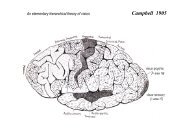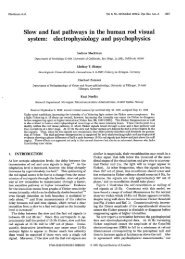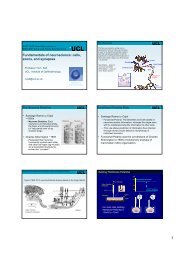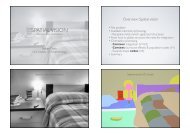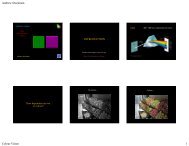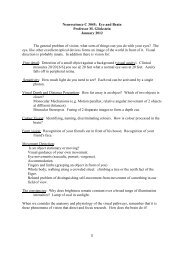Create successful ePaper yourself
Turn your PDF publications into a flip-book with our unique Google optimized e-Paper software.
<strong>Advanced</strong> psychophysics<br />
Steven <strong>Dakin</strong><br />
UCL Institute of Ophthalmology<br />
s.dakin@ucl.ac.uk<br />
Tasks, sampling methods and measures<br />
• Tasks (what does the subject do?)<br />
• Magnitude estimation (“how bright is it?”)<br />
• Detection (“is it there?”); yes/no requires criterion<br />
• Discrimination (“which is brighter”); forced choice is criterion-free<br />
Weber-Fechner<br />
Law<br />
Steven’s<br />
Power Law<br />
Introduction<br />
• To understand the brain, one must understand not only<br />
its components (e.g. physiology) and their purpose (e.g. via models)<br />
but also behaviour (e.g. psychophysics)<br />
• <strong>Psychophysics</strong> characterises the relationship between<br />
physical (e.g. visual) stimuli & behaviour (e.g. of humans). Reveals<br />
mechanism (e.g. trichromacy), links to other disciplines (e.g. via<br />
stats), clinical applications (e.g. diagnosis), etc.<br />
• Psychophysical experiments involve<br />
• A stimulus/phenomenon (e.g. illusions) Hard<br />
• A task (e.g. matching)<br />
• A method (e.g. adjustment)<br />
• A performance-measure (e.g. threshold,PSE)<br />
<strong>Psychophysics</strong>/<br />
methodology<br />
Tasks, sampling methods and measures<br />
• Sampling methods (how to select stimulus magnitude?)<br />
• Adjustment (under observer-control)<br />
• Method of constant stimuli (predefined set of stimulus magnitudes)<br />
• Staircase (select stimulus based on previous responses)
Tasks, sampling methods and measures<br />
• Measures: (how to characterise behaviour?)<br />
• Reaction times (how long to judge?). Atheoretical, but popular (e.g. IAT)<br />
• Percent correct (what level of performance at a fixed stimulus magnitude?): e.g.<br />
observers memorise 10 objects & are presented with a new set containing 5 they saw and 5<br />
they hadn’t. Observer #1 recognises them all, observer #2 none; both score 50% correct...<br />
• Point of subjective equality (stimulus mag. producing a perceptual match?)<br />
• Thresholds (minimum stimulus mag. producing some level of performance?).<br />
Absolute and relative...<br />
• Principled (signal detection theory). • Reliable/replicable<br />
• Efficient • Versatile<br />
• Stimulus<br />
(letter)<br />
Example I: Acuity<br />
• Method (method of constant stimuli)<br />
Letter size<br />
Correct<br />
Incorrect<br />
• Task(reading, 10AFC forced choice)<br />
Trial<br />
5 10 15 20<br />
Trial #<br />
Run<br />
“B” ✔ “N” ✔ “O” ✖ ...<br />
Appearance<br />
Performance<br />
• Performance measure<br />
(acuity threshold)<br />
1.0<br />
0.55<br />
0.1<br />
Psychometric<br />
function<br />
Acuity/size<br />
threshold<br />
• Stimulus<br />
(letter)<br />
Example I: Acuity<br />
• Task (letter<br />
identification)<br />
• Method (adjustment)<br />
Letter size<br />
[<br />
[<br />
Acuity threshold:<br />
Size leading to<br />
79.2% correct<br />
identification<br />
1 2 3<br />
Trial #<br />
• Performance<br />
measure<br />
(average setting = size<br />
threshold)<br />
Example I: Acuity<br />
• Method (adaptive staircase)<br />
Letter size<br />
5 10 15 20 25 30 35 40 45<br />
Trial #<br />
Correct<br />
Incorrect<br />
• Performance<br />
measure (threshold)
Example II: Contrast detection<br />
• Stimulus (disc)<br />
{ ΔL C=ΔL/Lback • Task (detection)<br />
“Yes” ✔ “No” ✔ “No” ✖<br />
...<br />
• Method (method of constant stimuli)<br />
×16 trials ×16 trials ×16 trials ...<br />
L<br />
Lback<br />
• Performance measure<br />
(absolute threshold)<br />
Prop. correct<br />
1.0<br />
0.75<br />
0.5<br />
Psychometric<br />
function<br />
Detection<br />
threshold<br />
0.0 0.1 0.2<br />
• Neurons give you a “noisy” code. If you used neural activity to<br />
make your judgement you can predict psychometric functions...<br />
• Consider orientation discrimination...<br />
σ<br />
Prob<br />
“CW”<br />
Thresholds<br />
Prob<br />
“CW”<br />
Prob<br />
“CW”<br />
• Means that thresholds measure σ your uncertainty<br />
about a stimulus or the width of your neural detector<br />
• Cumulative Gaussian psychometric function is integral<br />
of a Gaussian (hence use of 83% correct)<br />
1.0<br />
0.5<br />
0.0<br />
-3.0<br />
Psychometric<br />
function<br />
Contrast<br />
0.0 3.0<br />
Psychometric functions for detection and discrimination<br />
Proportion correct<br />
0.75<br />
Stimulus contrast<br />
0.0<br />
1.0<br />
0.5 1.0<br />
0.0<br />
1.0<br />
0.5<br />
1.0<br />
Better<br />
Worse<br />
0.83<br />
Slope∝<br />
1/threshold<br />
0.5<br />
threshold<br />
Proportion “2 “higher” is higher”<br />
0.5<br />
0.0<br />
Stimulus contrast<br />
PSE<br />
slope=<br />
threshold<br />
threshold<br />
• Two key psychophysical measures<br />
• Point of Subjective Equality (PSE) or bias measures appearance (accuracy)<br />
• Threshold (here, increment threshold) measures limits* of performance (precision)<br />
(*generally interested in best possible performance)<br />
(Accuracy versus precision: an accurate but imprecise clock, on average yields the right time, but individual readings vary wildly.<br />
An inaccurate but precise clock is e.g. reliably an hour slow)<br />
#1<br />
#2<br />
Shift=bias or<br />
appearance<br />
“Forced-choice” vs “Non-forced choice”<br />
• Experiment in which two or more alternatives are<br />
present (e.g. “which side is patch on?”, “which is bigger?”)<br />
• Some difference in convention as to whether both<br />
alternatives must be present e.g. tilt. i.e. is it<br />
the stimulus or the response?<br />
• If it’s response; detection is forced choice<br />
(actually 2AFC)<br />
“Criterion-free” vs “Criterion-dependent”<br />
• Yes/no means observer judges how strong stimulus must<br />
be to respond (“trigger happy”), forced choice does not<br />
• Different criteria bias subjects in detection. (Bias still arises in<br />
discrimination but no “trade-off”...)




